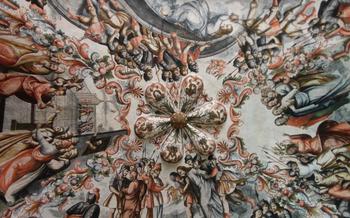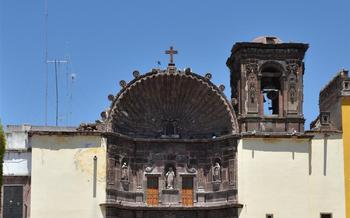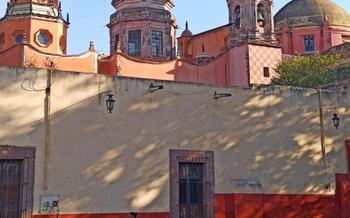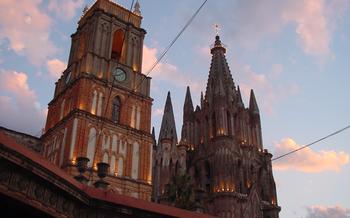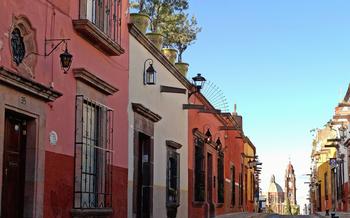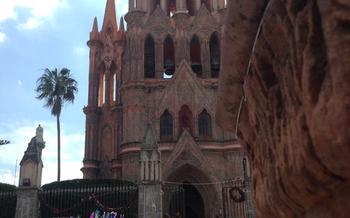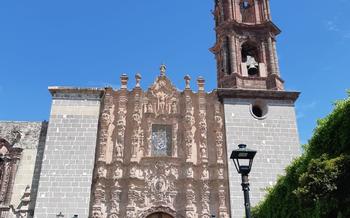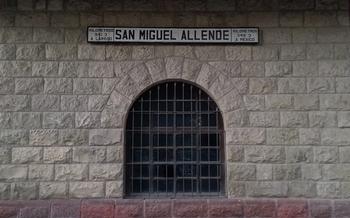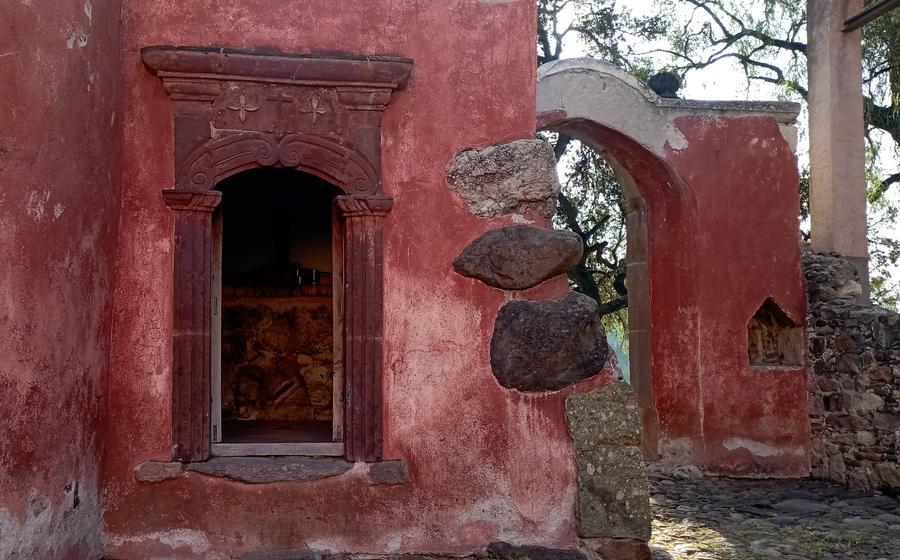
Galería Atotonilco
- A Baroque Masterpiece in the Heart of Mexico
- Exploring the Nave and Transepts
- Discovering the Sacristy and Chapel
- Interactive Displays and Multimedia Presentations
- Guided Tours and Workshops
- Accessibility for Visitors with Disabilities
- Planning Your Visit
- Local Cuisine and Dining Options
- Insider Tip: Unveiling the Hidden Treasure
A Baroque Masterpiece in the Heart of Mexico
In the heart of Mexico, nestled amidst the cobblestone streets of San Miguel de Allende, lies a Baroque masterpiece that transports visitors back to a time of artistic splendor - the Galería Atotonilco. Built in the 18th century, this architectural gem is a testament to the artistry and devotion of Miguel Antonio Martínez de Pocasangre, a renowned Mexican painter and sculptor. The gallery, with its intricate facade and vibrant interiors, serves as a sanctuary of sacred art, inviting visitors to embark on a journey through the life of Christ, depicted in breathtaking detail and vibrant colors. Its location within easy walking distance from the city center makes it a must-visit destination for art enthusiasts, history buffs, and anyone seeking a glimpse into Mexico's rich cultural heritage.
Exploring the Nave and Transepts
The nave and transepts of the Galería Atotonilco form the central and most expansive spaces within the gallery. The nave, with its soaring vaulted ceiling, creates a sense of grandeur and awe. The walls are adorned with a series of large-scale paintings depicting scenes from the life of Christ, arranged in chronological order. These paintings are executed with meticulous detail and vibrant colors, capturing the emotional intensity and drama of the biblical narratives.
The transepts, which intersect the nave at right angles, provide additional space for artwork. Here, visitors can find more paintings and sculptures, as well as several intricate altars. The interplay of light and shadow within the nave and transepts creates a dramatic effect, highlighting the details of the artwork and enhancing the overall atmosphere of the gallery.
The arrangement of the artwork within these spaces is carefully considered, with each piece contributing to the overall narrative and visual impact. Visitors can wander through the nave and transepts, taking in the artwork at their own pace, and immersing themselves in the stories and symbolism depicted.
The nave and transepts of the Galería Atotonilco are not simply spaces to view artwork; they are also places of worship and contemplation. The atmosphere within these spaces is one of reverence and spirituality, inviting visitors to connect with the sacred stories and reflect on their own faith.
Discovering the Sacristy and Chapel
The sacristy and chapel within the Galería Atotonilco are intimate spaces that contrast with the grandeur of the main gallery. The sacristy, where priests prepare for religious services, features a beautiful mural depicting the life of Saint Anthony of Padua. The chapel, dedicated to the Virgin of Loreto, houses a collection of religious artifacts and offers a serene atmosphere for prayer and contemplation. Visitors can appreciate the intricate details and symbolism of the artwork in these smaller spaces, gaining a deeper understanding of the religious and cultural context of the gallery.
Interactive Displays and Multimedia Presentations
The Galería Atotonilco has embraced technology to enhance the visitor experience through interactive displays and multimedia presentations. These tools provide a deeper understanding of the artwork and history of the gallery, creating a more engaging and immersive experience. Interactive displays allow visitors to explore the artwork in detail, zoom in on specific features, and access additional information about the artists and their techniques. Multimedia presentations offer a dynamic and visually appealing way to learn about the history and significance of the gallery. Through these interactive and multimedia elements, the Galería Atotonilco brings the past to life, making the gallery's rich cultural heritage more accessible and captivating to visitors of all ages.
Guided Tours and Workshops
The Galería Atotonilco offers guided tours and workshops to enhance the visitor experience and provide deeper insights into the artwork and history of the gallery. Guided tours are led by knowledgeable docents who share their expertise on the significance of the artwork, the stories behind the paintings, and the techniques used by the artists. These tours are available in various languages and can be booked in advance or upon arrival.
Workshops are also available for visitors who want to engage with the art on a more hands-on level. These workshops typically focus on specific aspects of the artwork, such as painting techniques, color theory, or iconography. Participants have the opportunity to create their own artwork inspired by the gallery's collection, under the guidance of experienced instructors.
Guided tours and workshops are a great way to gain a deeper understanding of the Galería Atotonilco and its cultural significance. They provide visitors with the opportunity to ask questions, learn from experts, and engage with the artwork in a meaningful way. Booking a guided tour or workshop is highly recommended to make the most of your visit to this extraordinary gallery.
Accessibility for Visitors with Disabilities
The Galería Atotonilco is committed to providing an accessible and inclusive environment for all visitors, including those with disabilities. The gallery is equipped with wheelchair ramps and elevators, making it easy for visitors to navigate the different levels and spaces. Accessible restrooms are also available for the convenience of visitors with disabilities.
To enhance the experience for visitors with visual impairments, the gallery offers audio guides that provide detailed descriptions of the artwork and history of the gallery. These audio guides can be rented at the information desk and are available in multiple languages. Additionally, the gallery staff is trained to assist visitors with disabilities and can provide any necessary assistance or information.
The gallery recognizes that accessibility is an ongoing process, and they are continuously working to improve the accessibility of the gallery for all visitors. If you have any specific accessibility needs or concerns, please contact the gallery staff in advance of your visit so that they can make the necessary arrangements to ensure a smooth and enjoyable experience for you.
Planning Your Visit
Timing is everything when planning a visit to the Galería Atotonilco. The best time of year to visit is during the shoulder seasons, from April to May and from September to October, when the weather is pleasant and the crowds are smaller. Avoid the peak tourist season from December to February, when the gallery can be packed with visitors.
Plan to arrive early in the morning or late in the afternoon to beat the midday heat and crowds. This will give you ample time to explore the gallery at your own pace and soak in the beauty of the artwork without feeling rushed. Allow at least two to three hours to fully appreciate the gallery's treasures.
The entrance fee to the gallery is 70 pesos (about $4 USD). Photography is allowed inside the gallery, but flash photography and tripods are not permitted. Guided tours are available for an additional fee and can be arranged in advance or upon arrival.
Combine your visit to the Galería Atotonilco with other attractions in the area. The nearby town of San Miguel de Allende is a UNESCO World Heritage Site and offers a wealth of cultural and historical attractions, including the Parroquia de San Miguel Arcángel, the Museo Histórico de San Miguel de Allende, and the Museo de las Momias.
Local Cuisine and Dining Options
After immersing yourself in the artistic and cultural treasures of the Galería Atotonilco, take a culinary journey and savor the delights of the local cuisine. San Miguel de Allende is a gastronome's paradise, offering a diverse range of restaurants and cafes catering to every palate. For an authentic Mexican experience, head to the Mercado de Artesanías, a vibrant market filled with food stalls serving up traditional dishes such as tacos, enchiladas, and pozole. Indulge in the flavors of freshly made tortillas, succulent meats, and tangy salsas.
For a more upscale dining experience, try one of the many acclaimed restaurants in the city center. La Sirena Gorda, known for its seafood specialties, offers a delectable selection of dishes prepared with the freshest ingredients. For a taste of modern Mexican cuisine with a twist, visit The Restaurant, where innovative chefs blend traditional flavors with contemporary culinary techniques.
Be sure to sample the local specialty, chiles en nogada, a dish of poblano peppers stuffed with picadillo, topped with a creamy walnut sauce, and garnished with pomegranate seeds. This dish, representing the colors of the Mexican flag, is a must-try for any visitor.
As you savor the delicious local cuisine, immerse yourself in the vibrant atmosphere of San Miguel de Allende, where food, art, and culture intertwine to create a truly unforgettable experience.
Insider Tip: Unveiling the Hidden Treasure
Beyond the main gallery, tucked away in a secluded corner, lies a hidden treasure that often goes unnoticed by visitors. It is a small, unassuming room known as the "Sala de Juntas" or the Meeting Room. This intimate space was once used by the Augustinian friars for private gatherings and discussions. Today, it houses a remarkable collection of paintings by Miguel Antonio Martínez de Pocasangre, the same artist who created the masterpieces in the main gallery.
These hidden paintings offer a unique glimpse into the artist's creative process and personal style. They are smaller in size and more experimental in nature, revealing a side of Martínez de Pocasangre that is not as evident in his larger works. Visitors who venture into this hidden room will be rewarded with a rare and intimate encounter with the artist's genius.
